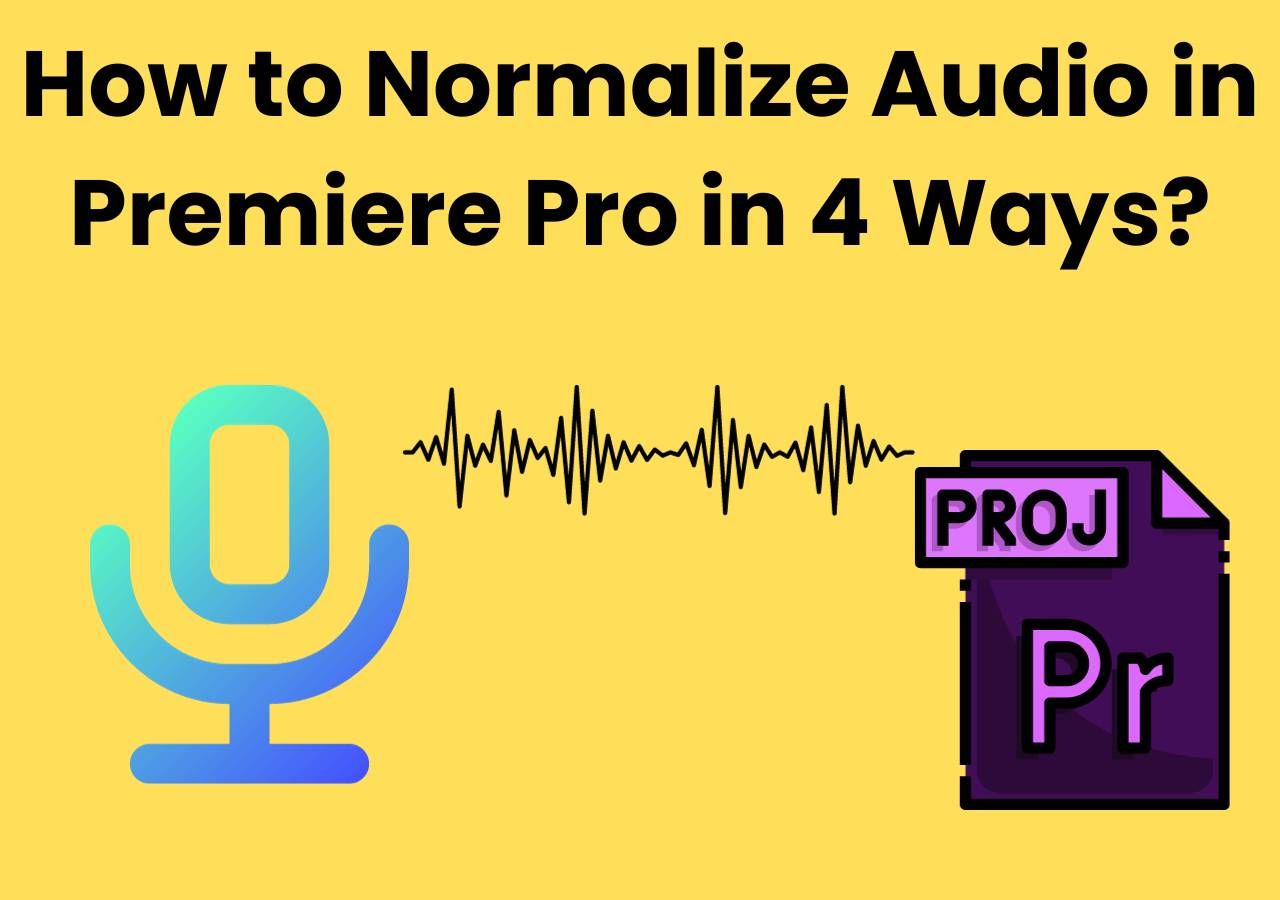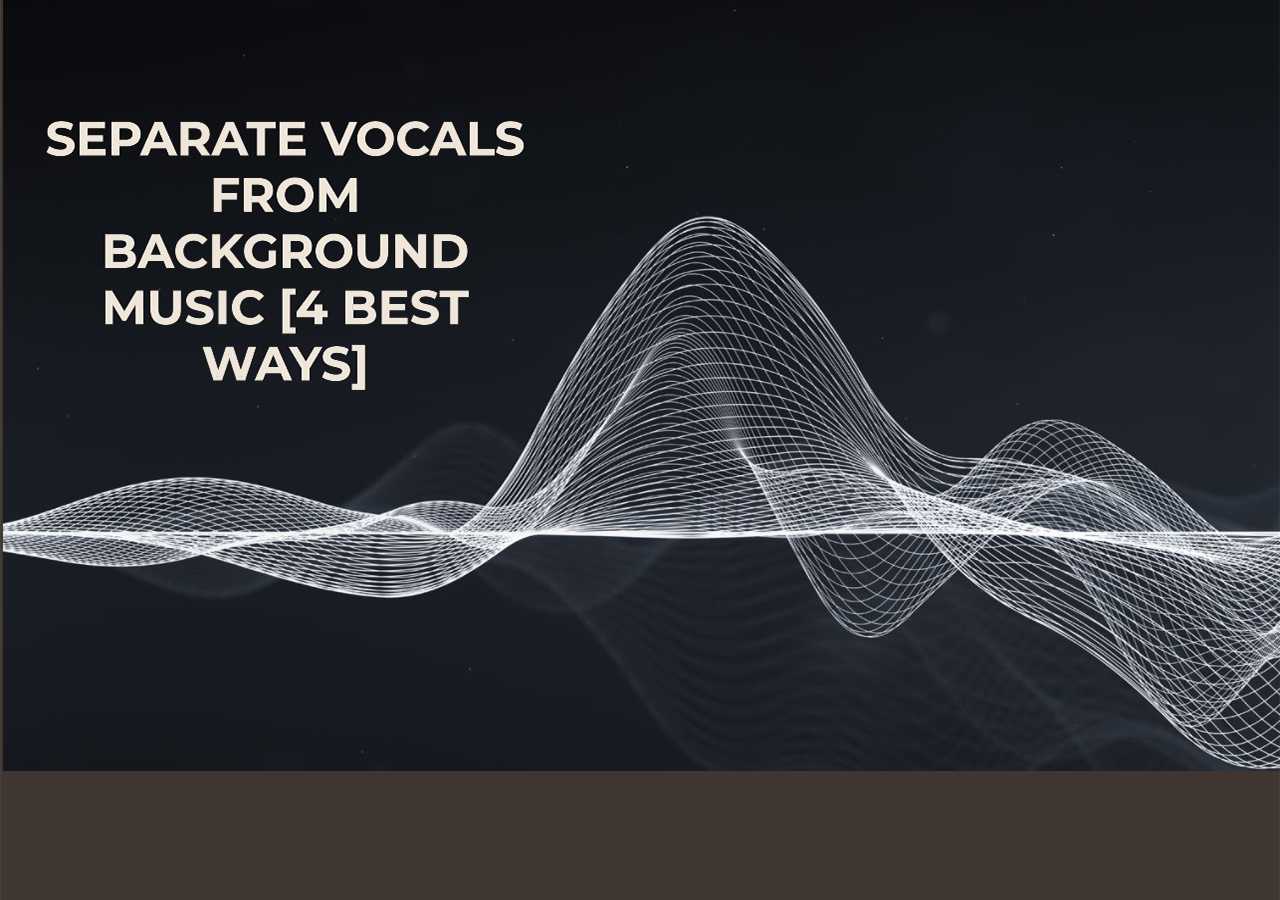-
![]()
Sofia Albert
Sofia has been involved with tech ever since she joined the EaseUS editor team in March 2011 and now she is a senior website editor. She is good at solving various issues, such as video downloading and recording.…Read full bio -
![]()
Melissa Lee
Melissa Lee is a sophisticated editor for EaseUS in tech blog writing. She is proficient in writing articles related to screen recording, voice changing, and PDF file editing. She also wrote blogs about data recovery, disk partitioning, data backup, etc.…Read full bio -
Jean has been working as a professional website editor for quite a long time. Her articles focus on topics of computer backup, data security tips, data recovery, and disk partitioning. Also, she writes many guides and tutorials on PC hardware & software troubleshooting. She keeps two lovely parrots and likes making vlogs of pets. With experience in video recording and video editing, she starts writing blogs on multimedia topics now.…Read full bio
-
![]()
Gorilla
Gorilla joined EaseUS in 2022. As a smartphone lover, she stays on top of Android unlocking skills and iOS troubleshooting tips. In addition, she also devotes herself to data recovery and transfer issues.…Read full bio -
![]()
Rel
Rel has always maintained a strong curiosity about the computer field and is committed to the research of the most efficient and practical computer problem solutions.…Read full bio -
![]()
Dawn Tang
Dawn Tang is a seasoned professional with a year-long record of crafting informative Backup & Recovery articles. Currently, she's channeling her expertise into the world of video editing software, embodying adaptability and a passion for mastering new digital domains.…Read full bio -
![]()
Sasha
Sasha is a girl who enjoys researching various electronic products and is dedicated to helping readers solve a wide range of technology-related issues. On EaseUS, she excels at providing readers with concise solutions in audio and video editing.…Read full bio
Content
Key Takeaways
Free Ways to Remove Static Noise from Audio Online
Other Best Ways to Remove Static Noise
How to Prevent the Static Noise in Audio?
Conclusion
FAQs on Removing Static Noise
5218 Views |
4 min read
Key Takeaways
✔️To remove static noise from audio in Audacity: Firstly, input your audio and select the section of the wave with static noise. Then, choose "Effect" > "Noise Reduction," and click on "Get Noise Profile" in the dialogue box. After that, select the track you want to apply this effect and re-open the noise reduction dialogue box by going to the "Effect" menu; choose "Noise Reduction" this time.
✔️Use EaseUS Online Vocal Remover to eliminate static noise faster by following these steps: Step 1. Select "Voice and Noise." Step 2. Click “Choose File" to input your file. Step 3. Download the final work with the noise removed.
In audio, static noise can be disruptive and annoying as it interferes with the clarity and quality of audio playback. People generally want to minimize or eliminate this noise for a better listening experience. However, removing static noise can be a challenging task. In such cases, the common approach to enhance the listening experience is to reduce or eliminate background noise.
Fortunately, you can now utilize various software tools to quickly remove static noise from audio without compromising the quality of the source file. After our testing, we have selected four background noise removal tools for you, online or downloadable. Let's get started. First, please glance at the table we made after testing.
| Methods | Effectiveness | Difficulty |
|---|---|---|
| EaseUS Online Vocal Remover | Remove various noises automatically and at no cost. | Super easy |
| VEED | Quickly process audio files for free with a 1 GB upload limit. | Simple |
| Audacity | Users can apply precise adjustments to eliminate unwanted noise. | Rather complex, but with more tutorials |
| Premiere Pro | Highly effective in removing static noise from video clips. | Rather complex |
Free Ways to Remove Static Noise from Audio Online
The fastest way to remove static is by using online tools. We have identified two free-to-use online background noise removers, and the process of using them for removal is quite simple. The first one is EaseUS Online Vocal Remover.
No 1. EaseUS Online Vocal Remover
As one of the best mp4 vocal removers online on the internet, it's worth mentioning that EaseUS Online Vocal Remover is completely free for any user, whether you're a professional or a beginner, as it doesn't require any audio editing experience. Throughout the entire process, you don't need to specify any settings; its artificial intelligence will automatically identify and eliminate various types of noise in your audio files, such as hissing and buzzing sounds. You won't be affected by unwanted noises and will get clean audio.
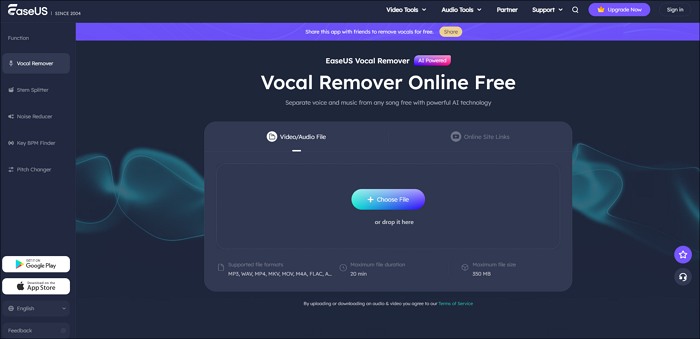
Moreover, in addition to being a background noise remover, it serves as a song vocal remover and a karaoke generator. You can use it for free to remove vocals from songs to create cover songs or to remove vocals from old recordings with degraded audio quality to restore the audio. For karaoke enthusiasts, you can use it for free to make a karaoke track or generate instrumental versions of any popular songs. How does that sound?
You can access the editing panel by clicking the button below to get started.
Below are the steps to use it to remove static noise from audio.
Step 1. Visit the website and select the "Noise Reducer" option.
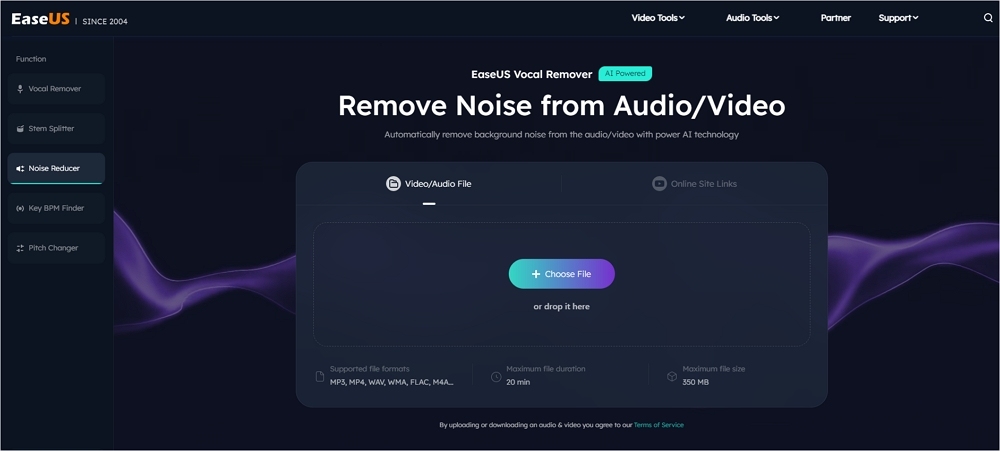
Step 2. Click "Choose File" or drag and drop the file in the area and wait for the AI analysis.
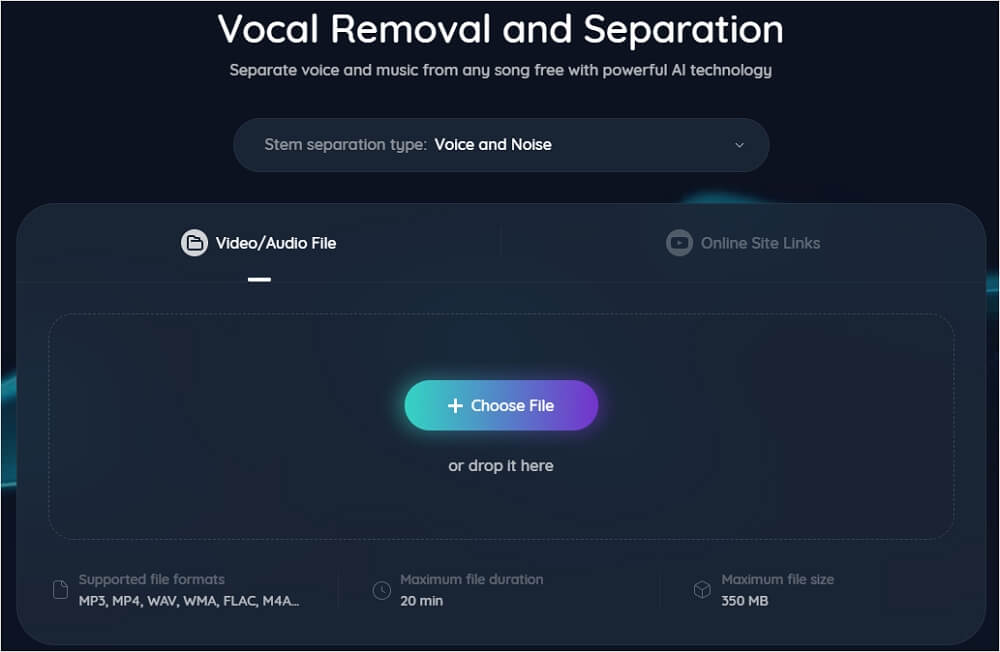
Step 3. Download the final work with noise removed.

No 2. VEED
With VEED, you can easily clean up audio and videos recorded in a home office environment. It can automatically remove background noises like wind, rain, traffic, static, and the humming of air conditioning with just one click. Similarly, it utilizes AI to detect and remove unwanted sounds from the background.
This video editing software also supports text-to-speech, removing background noise in videos, deleting background music, and replacing audio, among other features. While the free version does support background noise removal, please note that it includes watermarks on exports and has a maximum upload limit of 1GB.
You can follow the steps below to remove static noise with VEED online.
Step 1. Drag your audio file into VEED.
Step 2. Select the track, and then go to "Setting" > "Clean Audio." It will automatically remove the unwanted noise.
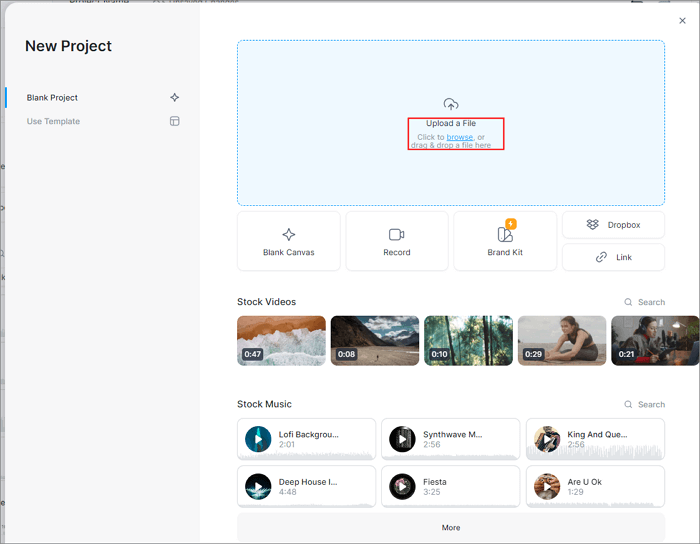
Step 3. Click "Export" to download your modified audio file. That's it!
You might also be interested in this:
VEED Subtitle Generator: Review and Alternative [2023]
If you are seeking a free automatic subtitle generator, you must have planned to install the VEED Subtitle Generator by now. But is this the perfect one, or do you need to consider it before proceeding? This passage will review the subtitle generator and its alternative to making informed decisions.

Think this article is valuable? Share it with more internet users using any of the following methods:
Other Best Ways to Remove Static Noise
In addition to online tools, if you have other classic video editing software like Audacity, Premiere Pro, and so on, they also have dedicated features to help users address this issue. Below, we have selected two of them.
No 3. Audacity
Audacity is an open-source, free-to-use audio recording and editing tool. It is widely acclaimed for delivering studio-quality sound. With Audacity, you can edit audio files in almost any format and adjust recording speed, pitch, and more. Its Noise Reduction feature can help remove background noise from audio, including static noise, or remove vocals from WAV files.
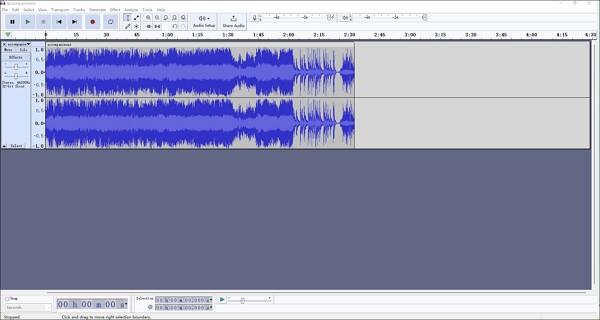
You may follow these steps to remove background noise in audio.
Step 1. Select the section of the wave that has static noise.
Step 2. Choose "Effect" > "Noise Reduction". A noise reduction dialogue box will pop out. Click on the "Get Noise Profile" button.

Step 3. Select part of the track or the entire track that you want to apply this effect, and re-open the noise reduction dialogue box by going to the "Effects" menu, then choosing "Noise Reduction."

No 4. Premiere Pro
Premiere Pro also provides various tools and features to help users enhance audio quality, including noise reduction functions. This feature assists in reducing various types of noise in audio, such as static noise, humming, or environmental sounds, enhancing the clarity of recorded audio. Its adaptive noise reduction can automatically analyze the audio and adjust the noise reduction settings accordingly, which helps achieve more effective noise reduction without compromising the desired audio quality.

Step 1. Open your project on Premiere Pro.
Step 2. Go to the effects windows and follow "Audio Effects" > "Noise Reduction/Restoration" > "Denoise."

Step 3. Drag and drop the denoiser effect to your audio clip.
Step 4. Go to the Effect Controls panel, find the "Denoise" effect, and click "Edit." This will open a new window where you can adjust audio frequencies.

Step 5. In this new window, you can use the "Amount" slider to define how much of the noise reduction effect you want to add to your audio. If you have no idea, play your audio to listen and reduce or increase if needed.
Due to the limitation of the length of the paper, only one method is provided. To learn more about it, please read:
How to Prevent the Static Noise in Audio?
Rather than dealing with various types of noise in post-processing audio, achieving perfection during audio recording is crucial. So, preventing the generation of different static noises during recording becomes essential. Before we delve into prevention techniques, let's understand what causes static noise in audio. We can summarize it into the following points.
- Audio Setting Errors
- Uncleaned Devices
- Micorphone Self-noise
- Faulty Cables or Connections
- Wireless Device Connectivity Issues
So, we have corresponding preventive measures:
- Regularly clean your devices.
- Check if the cables are correctly connected.
- Turn off any unnecessary electrical appliances and devices during recording.
- Use a good-quality microphone.
- Keep the microphone away from solid surfaces like walls or windows, etc.
Conclusion
If you have a file plagued by various background noises, such as static noise, you can carefully read the four methods mentioned above to obtain clean audio quickly. You can always find the most suitable method, whether a novice or a professional.
If you're unfamiliar with Audacity and Premiere Pro or don't know how to configure settings, you can try EaseUS Online Vocal Remover. It's still free for all users. Enter via the button below to start your journey.
FAQs on Removing Static Noise
The following section lists frequently asked questions on this topic and concise answers. We hope this can be of assistance to you.
1. How do I get rid of white noise in audio?
You can use noise reduction software like EaseUS Online Vocal Remover or audio editing software like Audacity to remove unwanted noise from your audio recordings.
2. How do I get rid of static noise in Windows 10?
You can update the sound card drivers.
Step 1. Right-click the "Start" button and choose "Device Manager."
Step 2. Navigate to the category labeled "Sound, video, and game controllers." Then, right-click on the driver for your "Realtek audio" card.
Step 3. From the context menu that appears, select "Update driver."
Step 4. Select the "Search automatically for updated driver software" option to automatically update the sound card driver.
3. Can Audacity remove white noise?
Yes, Audacity can remove white noise and other types of background noise. It has a built-in noise reduction effect that you can apply to your audio tracks.
4. Is there any way to eliminate white noise from mics?
Yes, you can eliminate white noise from mics using high-quality microphones, a noise gate, or employing noise reduction software.

